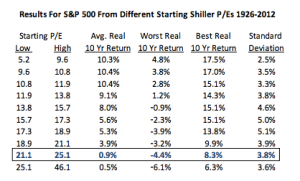I closed last week with a discussion of how, for individuals, the focus should be on actually achieving their goals, and how risk measures (and the portfolio design process) should be oriented to managing the risks that really matter—in my opinion, drawdowns.
Closely related to this is the issue of expectations. Just as variance of returns isn’t the best measure of risk for individuals, longer-run measures of return are also misleading in this context. Many of the guides put out for investors talk about long-run returns, focusing on the need to stay the course. Just as with rationality and variance, this is a pretty good approximation for institutional investors, who have that kind of long time frame and whose liquidity needs aren’t typically onerous. For individual investors, though, whose time frames are measured in a handful of decades at most (and who will actually need to spend the money at some defined point), this is misleading and damaging. As we have seen, there can be multi-decade periods where, in fact, returns do not match previous expectations—and if the money isn’t there when needed, the investment process has failed.
In designing portfolios, then, it is important to match expectations with likely time frames, including planning horizons as well as life spans, and also to consider market environments. To say that expected returns are the same no matter the market environment is simply incorrect. Extensive research, including my own, shows that future returns are correlated very strongly with initial valuations. Someone buying stocks at a P/E of 40 is simply going to make less money—or even lose money—compared with someone buying stocks at a P/E of 5. These differences may or may not wash out over a very long time period. But over a typical investor’s lifetime, they will not.
The reason is simple. In theory, earnings belong to shareholders, so a P/E of 40 means the shareholders would get a 2.5-percent return on their money, while, at a P/E of 5, they would get a 20-percent return. If everything else is equal, except the initial price, the people who bought low can’t help but do better.
The counterargument is that when prices are higher—at, say, a P/E of 40—growth expectations are higher. The higher price reflects future growth and, therefore, does not compromise future returns. This makes perfect sense for an individual company, but, for the market as a whole, it cannot be the case. Corporate earnings growth is constrained by the growth of the economy. Companies can grow much faster than the economy as a whole for quite a while, but not indefinitely, as the law of large numbers will eventually kick in. Earnings growth for the market as a whole will therefore be more limited—and the initial price paid will be more determinative of future returns, as the ability to grow into the price will be more limited.
This isn’t just theory: actual returns have been lower over history when initial valuations are higher. Many analysts, including me, have published research that demonstrates this; others include GMO, AQR, and Crestmont Research. When stocks are expensive, you will, on average, make less. The following chart, from an AQR research paper, summarizes very well the results we all have come up with.
Since the AQR paper was published, the market has gotten even more expensive and now has a Shiller P/E of 25.6. Based on historical results, from where the market is right now, we can expect a real return of less than 1 percent, on average, over the next 10 years. Add inflation of, say, around 3 percent, and you’re looking at a nominal return of about 3.5 percent—well below what is often quoted as typical market returns. We also have a significant chance of losing money on a real basis over the next 10 years. This isn’t what people normally expect when they think about investing in the stock market. The mismatch between expectations and history is a recipe for disaster—unless things are different this time.
The question then becomes, is there a way to better match expectations with history? There are two possibilities: dial down expectations, or come up with a way to minimize the effects of investing in a high-valuation environment. Both will be necessary, but the more we can limit the downside exposure from an expensive market, the less we’ll need to cut back our expectations—and our future lifestyle. Tomorrow’s post will deal with one way to try and limit downside exposure.


 Print
Print



